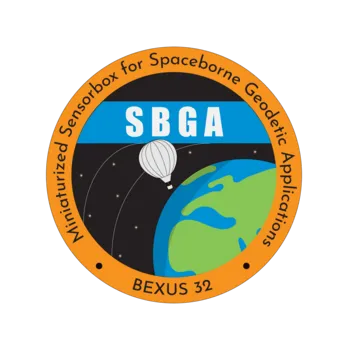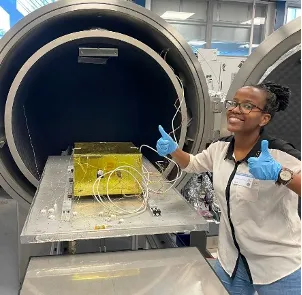BEXUS 32 – SBGA
Miniaturized Multi Sensor Box for spaceborne geodetic Applications

BEXUS – Balloon Experiments for University Students
The REXUS/BEXUS program allows students from universities and higher education colleges across Europe to carry out scientific and technological experiments on research rockets and balloons. Each year, two rockets and two balloons are launched, carrying up to 20 experiments designed and built by student teams. It is a joint program by the Swedish National Space Agency (SNSA) and the German Aerospace center (DLR) and supported by experts from DLR, SSC, ZARM and ESA. Further information can be found on the project’s homepage rexusbexus.net
Our Project – Miniaturized Multi Sensor Box for Spaceborne Geodetic Applications (SBGA)
SBGA is a team of students who study mostly ESPACE as well as Geodesy and Geoinformation. They have successfully proposed their experiment and have been selected to fly their experiment on the balloon BEXUS 32. Scientifically, the project is supported by the department’s chair Prof. Dr. Roland Pail and members of the department at large. The experiment’s main objective is to measure the vertical gradient of Earth’s gravity field and to assess the applied instruments’ quality by comparing the determined gradient to existing gravity field models. Therefore, inertial measurements are combined with GNSS measurements in a Kalman filter, which then separates gravitational and kinematic accelerations. The main sensors are two low-cost IMUs and two very cheap and small IMUs which are usually applied in other vehicles like smartphones, cars, airplanes or satellites. BEXUS 32 is scheduled to launch in September 2023 at Esrange in Northern Sweden and until then, the team must complete several review phases and prove our experiment's safety and functionality. In this way, our students gain experience in space-related programs. The general procedure of this project is very similar to usual projects in the space industry.
An Interdisciplinary Project for Students from various backgrounds
To successfully develop a balloon experiment, many different skills are required. As the experiment is of geodetic nature, most participants come from either the ESPACE Masters or Geodesy and Geoinformation. However, the project is addressed to other fields of study as well. It needs the combination of different skills in geodetic, electrical, aerospace and thermodynamic engineering.

Onboard the balloon, the acceleration, rotation and position are measured by IMUs and GNSS receivers and logged to an SD card and sent down to the ground via a down-link system. Additionally, the students have to take care of the power-supply management and face an environment of extreme temperatures and low pressure in an expected height of 25 km. The whole experiment including geodetic instruments and a Raspberry Pi is created by our students and must withstand this environment for multiple hours during the balloon’s flight. Therefore, the setup it must be well tested and fulfill mandatory requirements regarding safety and performance before launch. Additionally, a complete documentation of the entire program including a detailed description of the experiments’ design, functionality and tests as well as an overview on project management, human and financial resources is prepared by the students. Finally, the resulting data will be analyzed and published.
Achieved Results
1. Proposal
During the Summer semester 2021, the students worked on a theoretical description of the experiment. For the proposal of this project, the primary objectives were formulated: We want to determine a vertical gravity profile which can be used to compute the gravity gradient using low-cost IMUs and GNSS sensors. By comparing the resulting profiles to profiles which are computed with existing gravity field models, the accuracy and precision of the applied instruments shall be assessed. Furthermore, they gained first experiences with the applied instruments and started to read out the recorded data.
2. Selection Workshop
After submitting the experiment’s proposal, the students were invited to present their experiment on the selection workshop offered by DLR. They could convince the committee to choose their experiment as one of four German BEXUS projects. Furthermore, the students attended lectures on how to set up a preliminary design.
3. Preliminary Design Review
Besides the description of our objectives, the preliminary design document includes requirements concerning the precision of the applied instruments as well as the electronical and technical design. The students shall further provide a detailed description of planned tests and shall analyze possible risks in the implementation of the experiment. In this project phase, the principal concept of our project and its organization was given. This document had to be presented during the Student Training Week at the beginning of February, which was offered by experts of DLR, ESA, SNSA, SSC and ZARM. Furthermore, multiple lectures were given for our students concerning project management, electrical and technical implementation, software design, outreach opportunities and further relevant topics.
4. Critical Design Review
In May 2022 the students presented the status of the experiment during the Critical Design Review at ESA ESTEC in Leiden, Netherlands. This included an overview of the complete measurement cycle, as well as the mechanical, thermal, and electrical design of the experiment. Furthermore, they met the other student teams and project organizers in person for the first time and heard lectures on Space Mission Design and Testing.

5. Integration Process Review
After a rather long break, in May 2023 the team was visited by their Instructors from ZARM. They presented the status of the implementation and actual realization of the experiment and gave valuable feedback. The purpose of this review was to identify any critical points in the experiments design as well as the team’s timeline to ensure that everything will be working for the campaign.

6. Thermal Vacuum Test and Acceptance Review
The last big step before the launch of the experiment was the Thermal Vacuum Test and the Acceptance Review. For this the team was invited to visit ZARM in Bremen in August 2023. There, they performed a Thermal Vacuum Test, simulating the environmental conditions during the balloon flight. As a part of this test the communication and functionality of the experiment was verified under extreme conditions. This was the final test before the launch in September 2023.
The project is still ongoing. In future, further results will be published here. If you have any questions, want to participate as a student or support us for promotional purposes, feel free to contact the team.
Contact of the Project Management
team e-mail address: sbga.bexus.iapg(at)ed.tum.de
Source of pictures: ESA Education | https://rexusbexus.net/